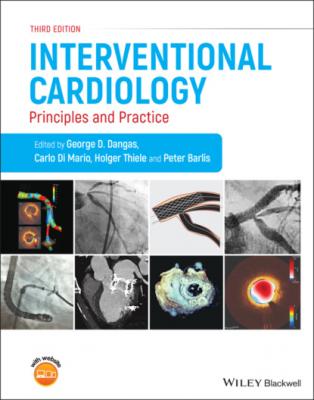Interventional Cardiology. Группа авторов
Читать онлайн.| Название | Interventional Cardiology |
|---|---|
| Автор произведения | Группа авторов |
| Жанр | Медицина |
| Серия | |
| Издательство | Медицина |
| Год выпуска | 0 |
| isbn | 9781119697381 |
Shape selection for the left coronary system
For the left coronary artery, catheters with a smaller curve will point upward and selectively engage to left anterior descending (LAD) and a larger curve will selectively engage and provide better support for the circumflex. The tip of Amplatz Left (AL) guides tend to point downward and are useful to selectively engage the circumflex in situations where there is a short or absent left main.
The shape of the guide catheter is an important component of the backup or support system that allows delivery of devices to the target lesion. Changing the guide catheter to improve support in the middle of a procedure can be problematic, and therefore careful consideration of guide support prior to intervention is critical. It is also important to appreciate that selection of a guide with optimal backup may obviate the need for stiffer wires or balloons, with a corresponding reduction in cost and procedure time. Although Judkins Left (JL) curves are commonly used for diagnostic intervention, these guide shapes provide less support than “backup” guides which provide contralateral aortic wall support such as the XB, EBU‐, or Q‐type curves. Because of the secondary curve on the JL, the tip may jump out of the coronary ostium when resistance is encountered. XB/EBU/Q/ Voda or similar curves provide comparatively more support with minimally increased risk of damage to the coronary ostia. AL curves are required in certain situations, but should only be used by experienced operators in view of the increased risk of iatrogenic dissection. Techniques to obtain support other than the passive support allowed by the guide catheter shape are discussed later in this chapter.
Shapes for commonly used guide catheters for the left coronary system are shown in Figure 5.1. The curve sizes of different shapes have been largely standardized and the comparable curve sizes used most commonly are shown in Table 5.3.
Figure 5.1 Shapes of a selection of guide catheters for the left coronary system.
Table 5.3 Comparability of curve sizes for different shapes of left sided guide catheters.
| AL (Amplatz) Curve | CLS or XB Curve | JL (Judkins Left) Curve | Q Curve | VL (Voda Left) Curve | |
|---|---|---|---|---|---|
| Normal | AL 1 or 1.5 | XB 4.0 or 3.5 | JL 4 | Q 4 | VL 4 |
| Dilated | AL 2 or 3.0 | XB 4.0 or 4.5 | JL 4.5 | Q 4.5 | VL 5 |
| Narrow | AL 0.75 | XB 3.0 or 3.5 | JL 3.5 | Q 3.5 | VL 3 |
Shape selection for the right coronary system
Shapes and sizes of commonly used guide catheters for the right coronary system are shown in Figure 5.2. The take off of the right coronary artery tends to vary more than that of the left coronary. If the take off is transverse, the most commonly used guide would probably be a Judkins Right (JR) 4. With a superiorly directed take off, a JR, Hockeystick, EBU‐R, or Amplatz R or L are more suitable. Inferiorly directed take offs can be cannulated with a multipurpose or SLS catheter. Although the JR shape does not provide much active support, the guide can often be actively engaged more deeply to augment support if required by “deep seating” it, ie advancement and clockwise rotation of the guide.
Figure 5.2 Shapes of commonly used guide catheters for the right coronary system.
Length
The standard length of a coronary guide catheter is 100 cm. Occasionally, shorter lengths (85 or 90 cm) are required to reach very distal lesions (e.g. LAD lesions via the left internal mammary artery (LIMA), distal native arteries via sequential saphenous vein grafts (SVGs), or retrograde approach to chronic total occlusions (CTO)). Longer lengths (110–115 cm) are required for unusually tall patients or severely tortuous aorto‐iliac vessels. The use of a long sheath and of longer balloon catheters (>145 cm) has partially overcome this problem but stent delivery catheters remain 135 cm.
Side holes or not?
Side holes help to maintain coronary perfusion when there is ostial obstruction by the guide catheter that results in pressure dampening. This can occur when using a larger guide caliber, in the presence of aorto‐ostial disease, non‐coaxial engagement, and in small caliber arteries encountered in smaller patients, often women. Side holes can reduce contrast opacification of the arteries with a consequent reduction in image quality and increased overall contrast dye utilization. The persistence of aortic pressure morphology can mask severe catheter‐induced pressure dampening which is of importance for measuring fractional flow reserve and may not always protect from hydraulically induced vessel dissection [2].
Variation in access site
The same guide catheters can be used for transradial access as well as transfemoral access. As a general rule, the same shape/size of the femoral artery apply using the left radial artery while for the right radial a ½ size smaller guide is often required. Dedicated transradial guide catheters include the Barbeau, Ikari, and brachial/radial curves. Such curves can be used for access to either the left or right coronary system and provide support against the contralateral aortic wall (Figure 5.3).
Figure 5.3 The Barbeau and radial/brachial curve catheters can be used via the radial route and have a “one size fits all” design for intervention to either the left or right coronary systems.
(Diagram courtesy of Cordis International.)
Vein grafts
Both
